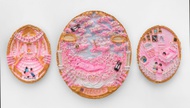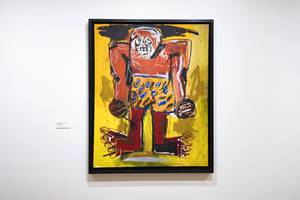
Justin Favela and Ramiro Gomez: Sorry for the Mess Through August 3; Monday- Friday, 9 a.m.- 5 p.m.; Saturday, noon-5 p.m. Marjorie Barrick Museum of Art, 702-895-3381.
Sorry for the Mess, a joint exhibition by Justin Favela and Ramiro Gomez, is an eye-opener. The 4,000-square-foot installation at UNLV’s Barrick Museum pays homage to the 85,000 Las Vegas casino employees who wash dishes, vacuum floors, clean rooms and mow lawns. Packed with sculptures and paintings made on-site (some in collaboration with Barrick Museum staff), Sorry for the Mess delivers wit, relevance and beauty.
The title—borrowed from a banner hanging during the Palms Casino reboot—points to the Las Vegas theme. The construction cycle characterizing the city’s continuous evolution is mirrored in the artists’ construction of self. Conceived as a series of collaborative “sets,” sequential installations dramatize aspects of the artists’ working-class biographies, including: a cardboard replica of the LA nursery where Gomez’s father loaded flowers to transport to Las Vegas casinos; a cardboard re-creation of Favela’s grandmother’s ornate Las Vegas sitting room; and a scale model of Ugo Rondinone’s Seven Magic Mountains on Interstate 15 made from painted tires. The generic materials (cardboard, crayons, rubber) and craft techniques (papier-mâché, piñata medium) feel naïve but are actually learned. Messages about the unseen laborers who built Las Vegas—and keep it running—infuse the gallery wonderland.
Among the highlights is Favela’s “Untitled (Muppet Pile),” featuring eight Jim Henson creations, from Slimey to Snuffleupagus, in a belly-up heap. Rendered life-size in piñata medium, their perky colors and adorable faces seem at odds with their compromised positions. Perhaps they’ve been discarded off-set or lost their footing, despite “Caution: Wet floor” signs warning that work is underway. Big Bird’s legs splay, his head resting on a trash can, his pals lumped over and under him in a Pop Art swan song of lost innocence familiar to immigrant children who learned English via Sesame Street. In keeping with the exhibition’s tight, formal coherence, the pyramidal puppet pile is echoed by other shapes—the towering silhouette of the Luxor Hotel Resort, for example, and the 21 “caution” signs with their triangular falling-figure ideograms reminiscent of Keith Haring. Ranging in height from 2 to 9 feet, the yellow cardboard “caution” signage offers an alternative Yellow Brick Road of labor.
Similarly impressive, Gomez’s “At the Casino (the lives they left behind for the work they do)” is a 40-foot-long tour de force of figurative painting. Presented in a nonlinear narrative, various figures—Gomez’s parents and Favela’s mom (painted at home) and anonymous casino workers (painted on the job)—alternate with weirdly poignant unpainted cardboard surfaces and a figurative cutout. The result is a delicate, mesmerizing composition symbolically recalling unseen labor through emotional portraits and “empty” space.
By using the artists’ biographies to humanize unseen labor, Sorry for the Mess skirts both identity politics and victimization narratives. Favela and Gomez’s artwork provides insight into Las Vegas, and by extension, our culture. Once again, the Barrick has mounted an innovative exhibition that makes our city proud.






